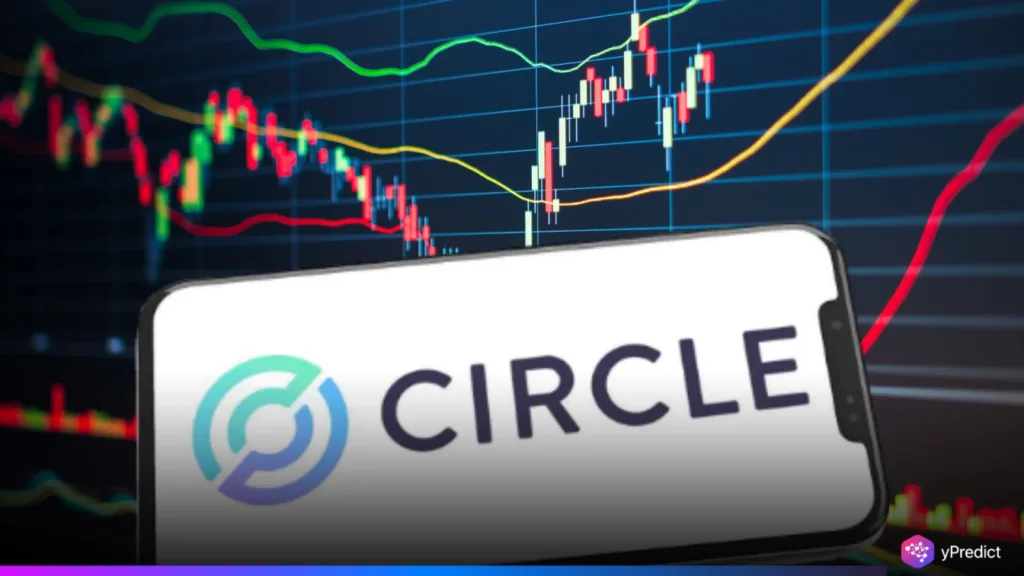
Circle delivered a standout performance in Q2 2025, with Circle Stock rallying sharply after the company posted impressive growth numbers. During the quarter, revenue soared, thanks to increases in USDC Circulation and rising Stablecoin Demand across the global crypto market. Investors showed strong buying demand, and analysts pointed to the availability of regulatory clarity as a key to future growth opportunities. The optimism comes too as the stablecoin market shifts towards mainstream emergence and may easily reach multiple trillion-dollar launches by 2030.
Revenue Surge Driven by USDC Circulation
Circle has experienced a 53% growth in revenue for the quarter compared to the prior quarter, which is an improvement over the prior quarter, posting an increase to $658.1 million. The uptick was driven by a 90% surge in USDC Circulation to $61.3 billion. This surge in USDC Circulation indicates strong Demand for Stablecoins, as more institutions and retail investors turn to USDC to pay for transactions and settlements and hedge against fiat volatility in a growing Stablecoin market. There are reasons to be positive about Circle, with increased USDC use fueled by a combination of regulatory clarity and educated scale that is preferring regulated Stablecoins over unregulated models, wider adoption of Stablecoins for cross-border payments, deeper integration of digital currencies in existing financial on-ramps, and stronger demand for regulated Stablecoins as individual fiati currencies are scrutinized by investors and companies seeking transparency and safety.
As a regulated operation with a compliance-first business model, Circle is piling up competitive advantages in the growing Stablecoin industry. Despite Tether’s dominant 67% market share, the acceleration in USDC Circulation signals that Circle is gaining ground. Analysts believe this momentum could continue if adoption trends and regulatory backing remain favorable.
Heavy IPO Costs Lead to Net Loss
In the same quarter that Circle showed its revenue was increasing, it reported $482.1 million in net losses in Q2, predominantly due to $591 million in non-cash IPO-related expenses. In short, these costs reflect the high costs of going public, even when investor demand is strong. The figures have sparked debate over the sustainability of Circle’s growth model in the face of such costs.
Some analysts argue that profitability may take longer to achieve, but others see the investment as a necessary step to secure market leadership. While USDC Circulation is growing rapidly, converting this growth into long-term earnings remains a key challenge. Tether’s larger market share underscores the scale of competition. Circle must continue building on its strong reputation to close the gap, while managing expenses linked to its expansion and public market presence.
IPO Debut Marks Historic Rise
Circle’s June 5, 2025, IPO turned heads across Wall Street and the crypto sector. Circle Stock soared 168% on its first day of trading, closing at $69. The debut was notable not only for the scale of the jump but also for the fact that Circle left an estimated $3 billion on the table due to underpricing.
IPO expert Jay Ritter from the University of Florida called it a rare event, reflecting both investor excitement and the unpredictable nature of the crypto-linked equity market. The rally reinforced Circle’s status as one of the widely followed companies in the digital asset sector. For investors, Circle’s IPO signified growing confidence in companies that combine blockchain innovation with operating in a regulated financial services context. The price action in Circle Stock indicates that there is still considerable demand for this group of companies.
Regulatory Push Shapes Stablecoin Outlook
Regulatory developments remain a pivotal piece of Stablecoin Demand and market direction. Recent ongoing legislative efforts continue the push to build a regulated system for stablecoin, potentially opening up a $ trillion market over the next 5 years. For Circle, the push for a regulated market is a continuing tailwind that may bolster the USDC Circulation growth and competitive environment. Analysts believe once regulation is clear, stablecoins will be adopted into mainstream payment systems, which means regulated issuers such as Circle will be the primary beneficiaries.
The next quarters will provide a test for Circle to gracefully land its momentum with positive equity, while managing profitability. The closer the stablecoin sector’s adoption moves towards institutional, there is little better impediment than what Circle has as a compliant, transparent, innovative issuer to help unlock the next evolution of digital finance growth.






